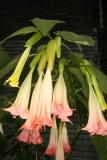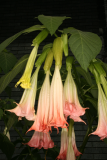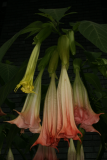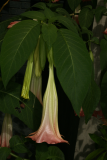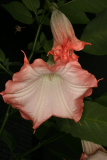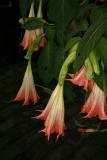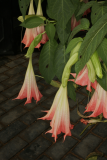Additional notes (click to expand)
Commemorative
Sebald Justinus Brugmans (24 March 1763, Franeker – 22 July 1819, Leiden) was a Dutch botanist and physician. He was the son of naturalist Anton Brugmans (1732-1789).[1]
Brugmans studied philosophy, mathematics and physics at the Universities of Franeker and Groningen, earning his doctorate in 1781. In 1785 he became a professor at Franeker, where he taught classes in physics, astronomy, logic and metaphysics. During the following year, he succeeded David van Royen (1727–1799) as professor of botany at the University of Leiden.[2] Here, he was also served as director of the Hortus Botanicus Leiden.[3] In 1791, he transferred from the Faculty of Philosophy to that of Medicine, which from 1795 included the field of chemistry. Brugmans was very interested in the connection between chemistry and medicine.[4]
In 1794, when Holland became a refuge for retreating English and Hanoverian armies, he, along with physicians and medical students at Leiden, set up an emergency hospital services outside the city. He repeated this activity in 1799 (for English and Russian forces north of present-day IJmuiden), and in 1809 (bombardment of Vlissingen by the British Navy).
In 1795, he became in charge of the military medical service of the newly founded Batavian Republic. His outstanding work as a physician came to the attention of Louis Bonaparte, as well as to his more famous brother, who promoted him to seventh inspector-general of the Grande Armee. Later, the first king of the Netherlands, William I, restored Brugmans to his former functions, while giving him additional duties as inspector-general of the military service, the supervision of the Navy and the Colonies, of the military veterinary service, and of sanitary conditions in prisons and quarantine stations.
As a military physician, he was dedicated towards the improvement of hospital and barrack facilities. In these endeavors, he stressed the importance of cleanliness and hygiene, and strove to prevent the spread of contagious disease. He is especially remembered for his expertise in the treatment of gangrene.[4][5]
wikipedia December 2013
Horticulture
Vigorous, semi-woody shrub or small tree 5m (15ft) high by 3m (8-10ft) wide, with ovate-oblong to narrowly elliptic, hairless or hairy, entire leaves, to 20 cm (8 inch) long. 'Pink Beauty' is a pink flowering cultivar. Large, solitary, pendant, tubular or trumpet-shaped, night-scented, pink flowers with 5 reflexed, pointed lobes, 30 cm (12inch) long, are borne from early summer to autumn. A mature specimen can display as many as 80 to 100 blooms at any one time.
Brickell, C. (2003). A-Z Encyclopedia of Garden Plants. Dorling Kindersley. Vol I, p.192
Sow seeds at 16°C (61°F) in spring. Root semi-ripe cuttings with bottom heat in summer. Once rooted under glass, grow in loam-based potting compost (JI No.3) in full light. From spring to autumn, water freely and apply a balanced liquid fertiliser every month; keep barely moist in winter. Outdoors, grow in fertile, moist but well-drained soil in full sun. In frost-prone areas, grow in a temperate greenhouse or conservatory over winter. Not hardy, minimum temperature 7°C/ 45°F.
Brickell, C. (2003). A-Z Encyclopedia of Garden Plants. Dorling Kindersley. Vol I, p.192
Medicinal
Prescription only medicine: scopolamine
Acetylcholine antagonists- contain scopolamine, used to dilate the pupil; speed up the heart; dry up saliva and gastric secretions, and to treat organophosphorous and mushroom poisoning & motion sickness.
Oakeley, Dr. H.F. (2013). Medicines from RCP plants label list 5-2013.docx.
There is a video by Dr Henry Oakeley
Videos from the garden
link
Nomenclature
Brugmansia-
named for Sebald Justin Brugmans (1763-1819) Professor of Natural History and Medicine, and director of the Botanical Garden at Leiden.
suaveolens-
from the Latin ‘suave’ meaning ‘sweet’ and, hence, ‘sweet-smelling’.
The trumpet-like, pendant flowers emit a delicious fragrance in the evening. Folk lore suggests that sleeping under it will bring death. However, analysis of the flowers' fragrance have not uncovered any lethal chemicals.
Oakeley, Dr. Henry F. (2013). Wellcome Library notes.
link
Other use
Many South American cultures use Brugmansia suaveolens ritually. Brugmansia aurea from the Andes has many cultivars and has been vegetatively propagated by shamans. B. sanguinea from Columbia to Chile, has been used as a traditional medicine and hallucinogen by American Indians.
Mabberley, D.J. (1997) The Plant Book, ed.2, Cambridge University Press p.124
The dried leaves were made into cigars, available on the National Health Service in 1948 to smoke as a treatment for asthma. As relaxation occurred and hallucinations were imminent, the patient's asthma was relieved. The leaves and flowers are dried and smoked around the world (in Australia the botanic gardens have to put fences round their plants to prevent theft) for their hallucinatory effects. Merely rubbing the flowers or leaves and then rubbing one's eye is sufficient to cause a dilated pupil, which may persist for three days (called 'gardener's mydriasis').
A contract worker at the Royal College of Physicians recounted drinking a tea made from the flowers (very bitter) of Brugmansia suaveolens at a beach party in South Africa and waking up 14 hours later with no memory of where he had been, covered in scratches and bruises, still with his surf board - but it appeared to have blue flames around the edges, and with tree small men in funny clothes and bobbly hats talking to him, who nobody else could see. He adamantly refused the offer of trying it again. Most tropane alkaloid induced hallucinations are perceived as unpleasant.
Repeated rubbing the leaves with ones fingers can cause long term numbness, and sufficient hyoscine can be absorbed through the skin to induce trances and hallucinations if the leaves are rubbed over the whole body. Hyoscine (scopolamine) was reputedly used as a 'truth drug' because of its disinhibiting effect. It is used in pre-operative premedication, partly as a tranquilizer, partly to reduce saliva and bronchial secretions, and - perhaps - to induce amnesia (in case the patient wakes up during the operation).
Oakeley, Dr. Henry F. (2013). Wellcome Library notes.
link
Phytochemistry
The whole plant contains high concentrations of tropane alkaloids: hyoscine (scopolamine), apohyoscine, norhyoscine, atropine (a racemic mixture of d- and l- hyoscyamine), noratropine, and tigloyl esters. The roots contain additional alkaloids. The flowers principally contain norhyoscine (Evans & Woolley, 1969). The tropane alkaloids block the peripheral actions of acetylcholine in the paraympathetic nervous system. They block the pupillary response to bright light, speed up the heart rate, reduce salivation and sweating, reduce gut motility and inhibit the vertigo and nausea of sea sickness. Centrally they disinhibit, relax, induce hallucinations, coma and death.
Oakeley, Dr. Henry F. (2013). Wellcome Library notes.
link
Toxicity
Brugmansia are members of the Solanaceae family and are poisonous if eaten, especially the seeds and leaves. Although handling the plant isn't dangerous, it is advisable to wash your hands once you have finished handling the plant.
Geographical distribution
- Southern America, Brazil
- Southern America, Western South America, Bolivia
- Southern America, Western South America, Peru
Brugmansia suaveolens (Humb. & Bonpl. ex Willd.) Bercht. & J. Presl 'Pink Beauty'
Family: SOLANACEAEGenus: Brugmansia
Species: suaveolens (Humb. & Bonpl. ex Willd.) Bercht. & J. Presl
Cultivar: 'Pink Beauty'
Common names: Angel's Trumpet
Distribution summary: Brazil, Bolivia, Peru
Habit: Shrub
Hardiness: H1c - Heated greenhouse; warm temperate
Garden status: Currently grown
Garden location: Wolfson Terrace (T), Poisons garden (PETO)
Flowering months: June, July, August, September
Reason for growing: Commemorative, medicinal, toxic, prescription only medicine
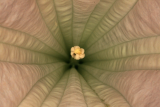


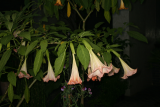
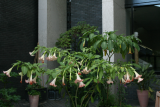
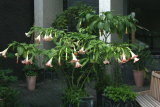
.JPG)
.JPG)
.JPG)
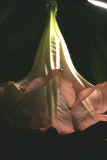
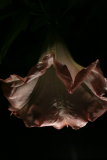
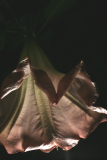
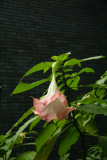

.JPG)
.JPG)
.JPG)
.JPG)
.JPG)
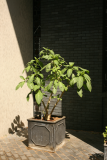
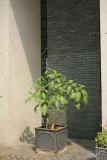
.JPG)
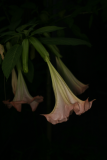
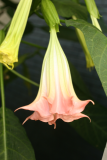
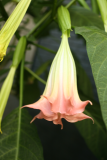
.JPG)
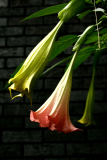
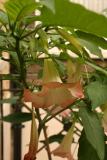
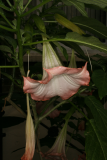
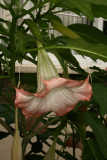

.JPG)
.JPG)


